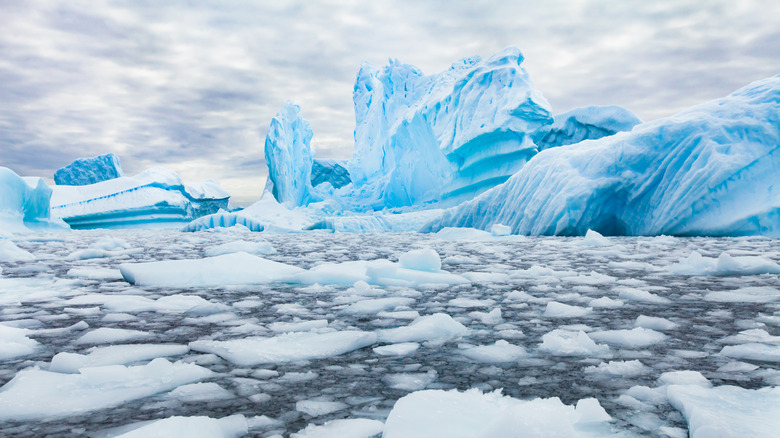Why The World's Largest Iceberg Is In Danger Of Melting
The world's largest iceberg, A-76A — a truly massive sight to behold at 84 miles long and 16 miles wide — may not hold that title for much longer. The colossal 'berg has made its way into the Drake Passage, where it will most likely be carried to warmer water currents in the north. This spells certain doom for A-76A, as it will slowly melt away, according to Live Science. Iceberg A-76A was "born" in May 2021 when it broke away from the prior record-holder for the world's largest iceberg. This former "world's largest iceberg" clocked in at the size of Rhode Island before it fractured into three separate segments. Of the three, A-76A was the largest.
Since then, the A-76A iceberg has floated around 1200 miles away from its parent iceberg and is now in the Drake Passage, which is located somewhere roughly in between Cape Horn (off the southern tip of Chile) and the South Shetland Islands (off the coast of Antarctica). Typically, icebergs that go into the Drake Passage drift north far enough until they reach the equator, where they will eventually meet their demise in the depths of the Atlantic Ocean, according to NASA.
Doomed to the sea
There was hope that A-76A could avoid its fate, as scientists have noted that the iceberg has seemingly not lost any mass as it has continually lumbered onward. This chance has been thwarted, however, as the iceberg has now reached the Drake Passage (via LiveScience). A-76A found its way there via the Antarctic Circumpolar Current (ACC), which is the only ocean current that circumvents the entire world. The ACC essentially dumps any iceberg that wanders in to the Drake Passage, and from there, a warm, watery grave is essentially inevitable.
However, this ginormous iceberg isn't the only frozen structure that faces melting at an unprecedented rate, as two of Antarctica's largest glaciers are also melting alarmingly fast (via LiveScience). These two glaciers are the Thwaites Glacier, known by the cheerful name "Doomsday Glacier," and the Pine Island Glacier. Scientists have uncovered that they are melting at a rate faster than they ever have in the past 5,500 years of their existence, and the results can be catastrophic. Since the glaciers are so dense, the fact that they are both melting quickly could mean that sea levels could rise globally by 11 feet over the next couple of centuries, according to Smithsonian. For context, this puts 85% of Miami-Dade county in the United States at risk of being underwater, as well as New York City, according to Climate Central.
Antarctic ice is growing
Despite the fact that these glaciers are melting faster than we've ever seen, for the most part, Antarctic sea ice has been growing — this has confused scientists who notice temperature rises on Earth. Older models in 2016 showed that the colder currents that surround the continent may have a larger impact on the climate of Antarctica than the average global temperature rising, according to Inside Climate News.
Other models show that when Antarctic ice breaks away from the northern part of Antarctica, it drifts upwards, before becoming more rugged and thicker, acting as a blocker for other smaller icebergs to grow in size, before expanding further out into the sea. However, ice hasn't been growing all across the world. Since the 1970s, in the Arctic, 20,800 square miles of ice have melted, whereas the Antarctic has only seen 7,300 square miles of ice grow. This colder climate could be a sign of hope for rapidly-melting ice formations. However, for A-76A specifically, it remains unlikely that this will happen, and most likely sooner than later, it will reach its ultimate demise.


